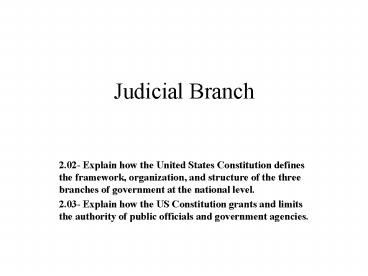Judicial Branch - PowerPoint PPT Presentation
1 / 9
Title:
Judicial Branch
Description:
2.02- Explain how the United States Constitution defines the framework, ... d) Impeach justices. 2. Executive: a) President appoints justices ... – PowerPoint PPT presentation
Number of Views:21
Avg rating:3.0/5.0
Title: Judicial Branch
1
Judicial Branch
- 2.02- Explain how the United States Constitution
defines the framework, organization, and
structure of the three branches of government at
the national level. - 2.03- Explain how the US Constitution grants and
limits the authority of public officials and
government agencies.
2
A. Establishment of the Supreme Court
- In Article III of the Constitution
- 1 Federal Court 50 State Courts
- Federal Courts
- Have 3 Levels
- 4. Jurisdiction courts
- authority to hear decide
- on cases
Supreme Court
Appeals Court
District Courts
3
B. Federal Courts
- Federal Court has exclusive jurisdiction over 8
kinds of cases (only they hear/decide these
cases) - a) Involving the Const- Ex denied freedom of
speech - b) Violations of Federal Laws- Ex kidnapping,
tax evasion, counterfeiting, patents, bankruptcy - c) Disputes between states- regarding boundary
lines, water claims, other property issues - d) Disputes between citizens of different
states- - e) Involving the Fed. Govt.- lawsuits were govt
can sue or citizens can sue the government - f) Involving Foreign Govt. Treaties-
- g) Accidents/Crimes on the High Seas-
- h) US Diplomats- If diplomat in another country
breaks an American law
4
C. State Courts
- Have jurisdiction over all other matters
- Most court cases involve state law state courts
- Some can be heard in both concurrent
jurisdiction
5
C. Federal Court Levels
- District Courts - - 550 judges
- a) all cases must begin here
- b) original jurisdiction- hear the cases for the
first time - c) determine the facts for the case
- 2. US Appeals Courts - - 6-27 judges
- a) appellate jurisdiction- review decisions from
lower courts - b) 12 court of appeals, but no trials 3 or
more judges decide to keep the first decision,
reverse the decision, or send it back to be tried
again
6
D. Supreme Court
- General information
- a) main job to decide whether laws are allowable
under the US Constitution - b) do not have to choose every case the lower
courts decisions will remain unchanged - c) final authority in cases w/ Constitution,
Congress, and treaties - d) no jury
- e) hear original and appellate jurisdiction
7
D. Supreme Court (contin)
- 2. Justices
- a) 8 associate justices and 1 chief justice
- (1) chief picked by Prez seniority, presides
over sessions (sits in the middle) - b) Appointed by President w/ approval of Senate
- (1) will choose someone w/ similar views
- (2) Senate can has rejected appointed
justices - c) 1st African American- Thurgood Marshall
(1967) - 1st Woman- Sandra Day OConnor (1981)
8
D. Supreme Court (Cont)
- 3. Powers
- a) legislative executive branches must
following their rulings - b) Judicial Review
- (1) decide if laws are constitutional
- (2) has power to cancel (nullify) a law
- (3) Not given to the SC in Const. but granted
- though Marbury vs Madison (1803)
- - helped give the judicial branch equal power
- - Const. is the supreme law of the land, the
constitution always wins, judicial branches
job is to uphold the constitution - c) Interprets laws made by Congress
9
E. Keeping the Judicial Branch in Check
- Legislative
- a) Pass a new or change an old law
- b) Adopting a new amendment to the Const.
- c) Approve justices being appointed
- d) Impeach justices
- 2. Executive
- a) President appoints justices































